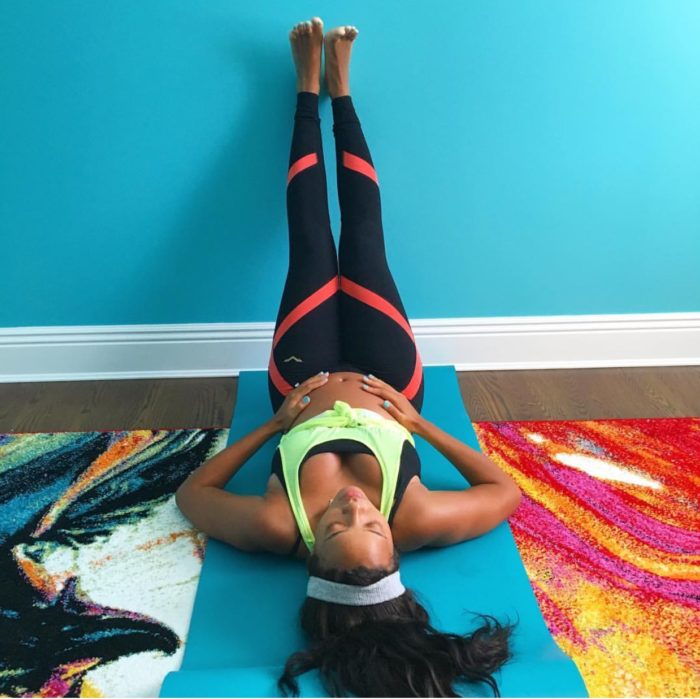
For many yogis, yoga practice is a sanctuary. Although yoga’s ability to soothe the mind and uplift the spirit doesn’t change once you’re pregnant, the way you approach you practice will be a bit different when you’re expecting. As your body changes, you will have to make modifications to stay comfortable (while still getting a nice workout) and stay safe. The following is a general guide for safely practicing yoga when you’re a mom-to-be.
What to Prioritize While Exercising When You’re Pregnant
Blood flow. Blood flow to your uterus is critical at all stages of your pregnancy. Any poses that constrict or put significant pressure on the area around your abdomen are best avoided (we’ll cover those in more detail in a bit).
Breath. Yoga is already good about prioritizing healthy breathing, but many of us have a tendency to hold our breath when we’re concentrating on a pose. When you’re pregnant, make sure you’re breathing regularly. Mama and baby need oxygen! Do not work to point where you’re struggling to catch your breath.
Balance. During exercise, make sure the risk of falling is as minimal as possible. As your belly grows, your center of gravity will feel different. You may also be more prone to feeling dizzy or lightheaded. Don’t hesitate to go to the wall or use a chair for modified standing positions.
Your body’s cues. Your pregnancy may feel different from day to day. Listen to your body, and never try to push yourself. Take breaks during class if necessary, and modify positions as much as you need to.
Additional tips:
—If you’re new to yoga, attend a prenatal-specific yoga class. Attending a prenatal class is a great way to meet other moms! If you’re a veteran yogi, feel free to attend regular yoga classes; simply let the instructor know that you’re pregnant.
—Be aware that the hormone relaxin softens your muscle tissue during pregnancy. This hormone allows your pelvis to expand to accommodate your baby during childbirth. You may feel like a real-life Gumby (i.e. super flexible) but go easy on the stretching. The increased presence of relaxin makes you more prone to muscle strain/pulls.
— When bending forward, hinge from the hips, keeping your back straight; minimize bending from the mid-lower back. Hinging at the hips allows more room for your belly. It’s also advisable to spread your legs when bending forward for the same reason—less constriction to the abdominal area. (Plus, spreading your legs is a great hip opener!)
—Avoid hot yoga/Bikram yoga or any asana practice that significantly raises your body heat. Raising body heat to around or above 102°F for longer than 10 minutes may put baby at increased risk of birth defects.
—Fitness expert at the Baby Center Tracey Mallet advises paying attention to the position of your pelvis throughout your yoga session: “Keep the pelvis in a neutral position during poses by engaging the abdominals and slightly tucking the tailbone down and in. This helps relax the muscles of your buttocks (your glutes) and the hip flexors, which can help reduce or prevent sciatic pain down the back of the leg, a common side effect of pregnancy. It also helps prevent injury to the connective tissue that stabilizes your pelvis.”
—When practicing gentle twists (never deep twists), twist from the upper back and shoulders rather than from the belly as you may be used to doing. Always twist from an open position–like sitting with legs open and gently twisting to the right or left. Avoid “closed” twists–like twisting in chair position with knees together.
—Chill out with the core. Overworking your core during pregnancy may increase your risk of diastasis recti—which occurs when your ab muscles become separated from the fibrous tissue intended to hold them together. (Imagine your six pack splitting down the center.) Although this common issue normally heals itself after baby’s arrival, it’s something to be aware of.
Yoga Avoid to Embrace During Pregnancy
Deep twists: these constrict the abdominal area
Core work except plank and forearm plank
Inversions: these put you at risk for falling
Poses on your back (after the first trimester)
Boat (or any asana resembling an abdominal crunch)
Upward bow
Camel
Yoga Poses to Embrace During Pregnancy
Standing and seating wide-leg forward folds: these stretch inner thighs and groin, which may help prepare you for labor.
Ditto seated bound angle pose.
Downward facing dog: temporarily relieves pressure on the cervix.
Legs up the wall: helps reduce leg and feet swelling
Have you practiced yoga while pregnant? What are your tips for practicing safely?
Related: Why Your Sex Life Needs Yoga
Best Resources for Your Vegan Pregnancy
The Connection between Yoga and Fertility
Get more like this–sign up for our newsletter for exclusive inspirational content!
__
Photo: Lathan Thomas via Instagram




